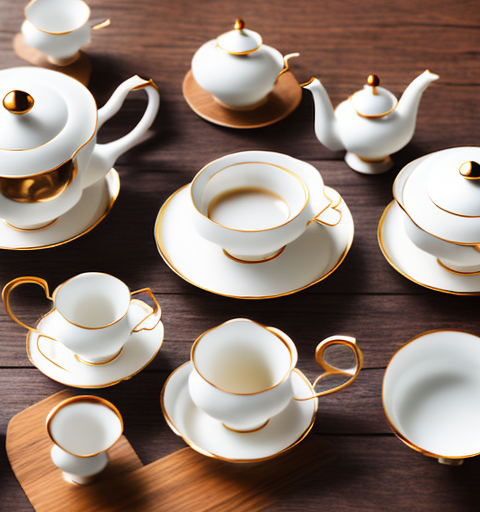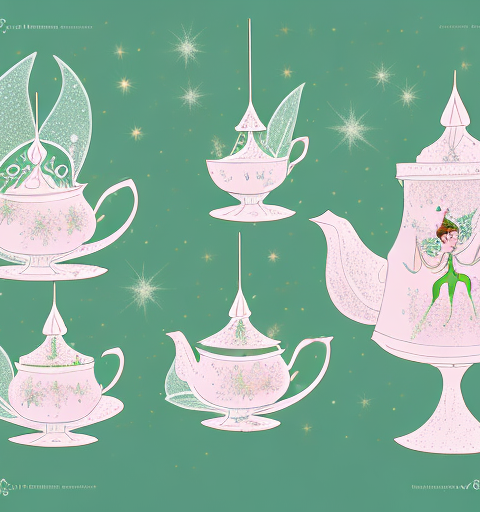If you have ever experienced the frustration of a lid falling off your ceramic teapot while pouring, you know just how inconvenient and messy it can be. In this article, we will explore the various reasons why this happens and provide you with several solutions to prevent lid displacement during pouring. Whether you are a tea enthusiast or simply someone who enjoys a hot cup of tea, this comprehensive guide will help you keep your ceramic teapot’s lid secure and ensure a spill-free pouring experience.
Understanding the issue: Why does the lid of a ceramic teapot fall off while pouring?
Before diving into the solutions, it is essential to understand why this problem occurs in the first place. The primary reason for the lid falling off a ceramic teapot while pouring is poor design or fit. Many generic teapots are mass-produced and may not have been carefully designed to ensure a secure lid. Additionally, the weight and balance of the teapot, as well as the force exerted while pouring, can contribute to lid displacement. Furthermore, the build-up of steam and heat inside the teapot can also affect the stability of the lid.
Another factor that can contribute to the lid falling off a ceramic teapot while pouring is the quality of the materials used. Some teapots may be made from low-quality ceramics that are more prone to cracking or breaking, leading to a loose or unstable lid. Additionally, the age and condition of the teapot can also play a role. Over time, the ceramic may become worn or weakened, making it more likely for the lid to come off during pouring. It is important to consider these factors when selecting a ceramic teapot to ensure a secure and enjoyable tea-drinking experience.
The importance of a secure lid: Why is it crucial to prevent the lid from falling off?
A secure lid is essential for several reasons. Firstly, it prevents any accidental spillage or burns caused by hot tea escaping from the teapot. Secondly, a loose lid can disrupt the brewing process, as it may allow heat and steam to escape, affecting the taste and aroma of the tea. Lastly, a secure lid adds aesthetic value to the teapot, enhancing its overall appearance and functionality.
One additional reason why a secure lid is crucial is that it helps to maintain the temperature of the tea. When the lid is tightly closed, it creates a seal that traps the heat inside the teapot, keeping the tea hot for a longer period of time. This is especially important for those who enjoy savoring their tea slowly or for tea parties where the tea needs to stay warm throughout the gathering.
Furthermore, a secure lid also plays a role in preserving the freshness of the tea. By preventing air from entering the teapot, it helps to minimize oxidation, which can negatively impact the flavor and quality of the tea. This is particularly important for delicate teas that are easily affected by exposure to air, such as green or white teas.
Examining the design: Is the teapot lid causing the issue or is there another underlying problem?
When faced with a lid that constantly falls off, it is vital to assess whether the problem lies with the teapot lid itself or if there is an underlying issue. Start by inspecting the lid closely for any visible defects, such as chips or cracks. These could significantly contribute to the lid’s instability. Additionally, consider the size and shape of the teapot opening. If the lid does not fit perfectly or is too small for the opening, it will be prone to displacement during pouring.
Another factor to consider when examining the teapot lid is the material it is made of. Different materials have varying levels of durability and heat resistance. For example, a plastic lid may be more prone to warping or melting under high temperatures, leading to a loose fit. On the other hand, a metal lid may be more sturdy and secure.
In addition to the lid itself, it is important to evaluate how the lid is attached to the teapot. Some teapots have a simple friction fit, where the lid rests on top of the opening without any additional locking mechanism. This type of design can make the lid more susceptible to falling off. Alternatively, other teapots may have a locking mechanism, such as a latch or a twist-lock, which provides a more secure closure.
Tips for proper positioning: How to position the lid correctly for a secure pour?
Proper lid positioning is key to prevent displacement and ensure a secure pour. Start by placing the lid flat on top of the teapot and aligning it with the handle. Gently press down to secure it in place. Be careful not to tilt or force the lid, as this can lead to misalignment and instability. Make sure the lid is centered and covers the entire opening of the teapot to create a tight seal.
Additionally, it is important to check for any obstructions or debris on the rim of the teapot before placing the lid. Any particles or residue can prevent the lid from forming a proper seal, resulting in potential leaks or spills during pouring. Take a moment to wipe the rim clean with a damp cloth or rinse it under running water to ensure a clean surface for the lid to rest on. This simple step can greatly improve the effectiveness of the lid’s positioning and enhance the overall pouring experience.
Assessing the fit: Checking if the lid and teapot are a perfect match for each other.
Ensuring a perfect fit between the teapot lid and the body is crucial for lid stability. It is recommended to examine if the lid was specifically designed for the teapot you are using. If it is not an original lid or an accessory recommended by the manufacturer, there is a higher likelihood of fit issues. If you suspect that the lid is not the right match, consider exploring alternative options or contacting the teapot’s manufacturer for assistance.
One way to assess the fit between the lid and teapot is to visually inspect the alignment of the lid with the teapot’s opening. The lid should sit flush on the teapot without any gaps or wobbling. Additionally, you can try gently pressing down on the lid to see if it securely stays in place. If the lid easily moves or pops off, it may indicate a poor fit.
Another factor to consider when assessing the fit is the material of both the lid and teapot. Different materials can expand or contract with temperature changes, which may affect the fit over time. For example, if the lid is made of metal and the teapot is made of ceramic, they may have different rates of expansion and contraction. It’s important to choose materials that are compatible and minimize the risk of fit issues.
Exploring alternative options: Are there any replacement lids or accessories available to solve this problem?
If you have determined that the current lid is not providing the stability you need, consider exploring alternative options. Some teapot manufacturers offer replacement lids or accessories specifically designed to improve lid stability. These may feature enhanced designs, such as better grip or innovative mechanisms to secure the lid in place. Make sure to choose options that are compatible with your teapot’s make and model.
Additionally, you can also consider looking for universal replacement lids or accessories that are compatible with a wide range of teapot makes and models. These universal options may offer a versatile solution to your lid stability problem. Before purchasing, double-check the dimensions and specifications to ensure a proper fit for your teapot.
The role of heat and steam: Understanding how temperature affects the stability of the teapot lid.
Heat and steam can have a significant impact on the stability of the teapot lid. As the water inside the teapot reaches boiling point, steam is produced, creating pressure inside the vessel. This pressure can cause the lid to loosen or even pop off if it is not securely positioned. To minimize the impact of heat and steam, ensure that the lid is tightly closed and properly aligned before pouring. Avoid overfilling the teapot, as this can create excessive pressure, compromising the lid’s stability.
Troubleshooting common issues: How to fix loose or wobbly lids on ceramic teapots.
If your ceramic teapot lid is consistently loose or wobbly, there are several troubleshooting steps you can take to address the issue. First, inspect the lid and teapot for any visible defects or damage. If you spot any chips or cracks, it may be time to consider a replacement lid or teapot. Alternatively, you can try using small cushions or adhesive strips to improve the fit between the lid and teapot. These may help create a tighter seal and minimize lid displacement during pouring.
The art of pouring: Techniques to pour from a ceramic teapot without dislodging the lid.
Pouring from a ceramic teapot can require a delicate touch to avoid lid displacement. Start by gripping the teapot’s handle firmly with one hand and holding the lid in place with your other hand. Tilt the teapot slowly and steadily to pour the tea, making sure not to put too much force or create sudden movements. By maintaining control throughout the pouring process, you can prevent the lid from falling off and enjoy a spill-free experience.
Maintenance and care tips: How to keep your ceramic teapot’s lid secure for a long time.
Regular maintenance and proper care are essential for keeping your ceramic teapot’s lid secure and functional for an extended period. After each use, clean the lid and teapot thoroughly to remove any residue or tea stains that may affect the lid’s stability. Avoid exposing the teapot to sudden temperature changes, as this can cause stress and affect its overall structure. Store the teapot in a safe and stable place, protecting it from accidental knocks or falls that could damage the lid.
DIY solutions: Step-by-step guide on making your own custom lid lock for a ceramic teapot.
If you enjoy do-it-yourself projects, you can create a custom lid lock to keep your ceramic teapot’s lid secure. Start by measuring the diameter of the teapot opening and the lid. Then, using sturdy materials such as silicone or rubber bands, create a loop that wraps around both the teapot and lid. Adjust the size of the loop until it fits snugly around both components, providing the necessary stability. This DIY solution can be a cost-effective way to enhance the lid’s performance and prevent displacement.
Expert recommendations: What do tea enthusiasts and professionals suggest to prevent lid displacement during pouring?
Tea enthusiasts and professionals often provide valuable insights and recommendations to prevent lid displacement while pouring from a ceramic teapot. Some experts suggest investing in teapots with specially designed lids, which may feature locking mechanisms or improved material quality. Others emphasize the importance of proper lid positioning and handling techniques. Additionally, seeking advice from knowledgeable tea sellers or attending tea workshops can provide you with first-hand tips and recommendations.
Exploring different types of teapots: Are there certain styles or materials that provide better lid stability?
When selecting a ceramic teapot, consider exploring different styles and materials that can provide better lid stability. Teapots with a wider base and a heavier weight tend to offer increased stability, as they are less likely to tip over or cause the lid to dislodge during pouring. Additionally, certain materials, such as cast iron or stoneware, are known for their durability and secure lid designs. Understanding the characteristics of different teapot types can help you make an informed choice and minimize lid displacement.
Safety precautions: How to ensure hot tea doesn’t spill while dealing with an unstable lid.
Dealing with an unstable lid can increase the risk of hot tea spills and burns. It is crucial to take appropriate safety precautions to minimize these risks. Always pour the tea slowly and steadily, using a firm grip on the teapot handle and ensuring the lid is firmly in place. Consider using a tray or saucer underneath the teapot to catch any potential drips or spills. For an added layer of safety, wear oven mitts or use a tea cozy to insulate and protect your hands while handling the teapot.
Recognizing when it’s time for a new teapot: Signs that indicate you may need to replace your current teapot due to persistent lid issues.
Despite your best efforts, persistent lid issues may indicate that it is time to replace your current teapot. If you have explored various solutions and still experience frequent lid displacement, it may be a sign that the teapot’s design is inherently flawed or that the lid and teapot are not compatible. Additionally, if the teapot or lid is significantly damaged or poses a safety risk, it is recommended to invest in a new teapot to ensure a secure and enjoyable tea experience.
Addressing common misconceptions about ceramic teapot lids and their stability.
There are several common misconceptions about ceramic teapot lids and their stability that need to be addressed. One common misconception is that all ceramic teapot lids are supposed to fit tightly and never fall off. In reality, the fit and stability of teapot lids can vary depending on design and material factors. It is important to find the right balance between a secure fit and ease of use. Another misconception is that a lid that falls off occasionally is a sign of poor quality. While consistent lid displacement can be a concern, occasional movement may occur due to normal factors such as temperature changes or handling technique.
Customer reviews and recommendations for ceramic teapots with secure lids.
When searching for a ceramic teapot with a secure lid, it can be helpful to read customer reviews and recommendations. Many online retailers and tea-related websites feature customer ratings and feedback on various teapot models. Look for teapots that consistently receive positive reviews for lid stability, ease of use, and overall quality. Additionally, consider reaching out to fellow tea enthusiasts or joining online tea communities to benefit from their experiences and recommendations.
Repair options for damaged or broken lids on ceramic teapots.
If you find yourself with a damaged or broken lid on your ceramic teapot, there are repair options available. Depending on the extent of the damage, you may be able to repair the lid using food-safe epoxy or adhesive specially designed for ceramics. However, keep in mind that repaired lids may not provide the same level of stability as a new or undamaged lid. If the damage is extensive or compromises the lid’s functionality, it may be more practical to consider purchasing a replacement lid or teapot.
Final thoughts and conclusion: Summing up key points and providing a comprehensive solution to prevent lid displacement while pouring from a ceramic teapot.
In conclusion, preventing the lid of your ceramic teapot from falling off while pouring requires careful consideration of design, fit, heat, and pouring techniques. By ensuring a proper fit, positioning the lid correctly, and paying attention to the teapot’s balance and weight, you can minimize lid displacement. Additionally, exploring alternative options, seeking expert recommendations, and taking proper care of your teapot can significantly enhance lid stability. Remember to prioritize safety and be mindful of hot tea spills. By following the tips and solutions outlined in this article, you can enjoy a secure and pleasurable tea pouring experience every time.






